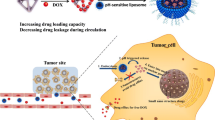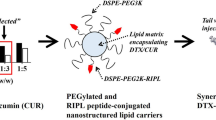Abstract
Purpose
We developed a core–shell (CS) nanoparticle, docetaxel (DTX)-loaded core and tariquidar (TRQ)-loaded shell conjugated with PEG and RIPL peptide (D/C-T/S-PR), which sequentially releases TRQ and DTX to overcome multidrug resistant (MDR) cancer.
Methods
D/C-T/S-PR was fabricated by two-step method, including the formation of a DTX-loaded nanostructured lipid carrier (D/NLC) core by solvent emulsification-evaporation and a TRQ-loaded lipid bilayer shell using a film hydration method. CSs with a lipid mass ratio of shell to core from 1 to 5 (CS1–CS5) were prepared and purified by sucrose density gradient centrifugation. The physicochemical properties of the CSs were evaluated to select an optimal ratio. Additionally, CS formation was confirmed by transmission microscopy (TEM) and confocal laser scanning microscope (CLSM) images. In vitro drug release was evaluated and in vitro cellular uptake and cytotoxicity were assessed against MCF7 and MCF7/ADR cells.
Results
The amounts of CSs acquired after purification were increased with increasing lipid ratio. CS3 was selected as the final formulation due to its high drug loading. Using TEM, we observed the distinct formation of the shell coating the core in the D/C-T/S-PR, while CLSM was used to confirm the co-loading of two fluorescent probes in different layers. D/C-T/S-PR showed a burst release of TRQ from the shell, followed by sustained release of DTX from the core. D/C-T/S-PR showed enhanced uptake and cytotoxicity in both cell types.
Conclusion
We successfully developed a CS exhibiting sequential release of TRQ and DTX, which may represent a promising strategy to overcome MDR.






Similar content being viewed by others
References
Cipolla D, Wu H, Gonda I, Eastman S, Redelmeier T et al (2014) Modifying the release properties of liposomes toward personalized medicine. J Pharm Sci 103:1851–1862
Fang J, Nakamura H, Maeda H (2011) The EPR effect: unique features of tumor blood vessels for drug delivery, factors involved, and limitations and augmentation of the effect. Adv Drug Deliv Rev 63:136–151
Guo Y, He W, Yang S, Zhao D, Li Z et al (2017) Co-delivery of docetaxel and verapamil by reduction-sensitive PEG-PLGA-SS-DTX conjugate micelles to reverse the multi-drug resistance of breast cancer. Colloids Surf B 151:119–127
Herbst RS, Khuri FR (2003) Mode of action of docetaxel–a basis for combination with novel anticancer agents. Cancer Treat Rev 29:407–415
Jang MH, Kim CH, Yoon HY, Sung SW, Goh MS et al (2019) Steric stabilization of RIPL peptide-conjugated liposomes and in vitro assessment. J Pharm Investig 49:115–125
Jiang L, Lee HW, Loo SCJ (2020) Therapeutic lipid-coated hybrid nanoparticles against bacterial infections. RSC Adv 10:8497–8517
Kalam MA, Alkholief M, Badran M, Alshememry A, Alshamsan A (2020) Co-encapsulation of metformin hydrochloride and reserpine into flexible liposomes: characterization and comparison of in vitro release profile. J Drug Deliv Sci Technol 57:101670
Kang MH, Park MJ, Yoo HJ, Lee SG, Kim SR, Yeom DW, Kang MJ, Choi YW (2014) RIPL peptide (IPLVVPLRRRRRRRRC)-conjugated liposomes for enhanced intracellular drug delivery to hepsin-expressing cancer cells. Eur J Pharm Biopharm 87:489–499
Kim CH, Sung SW, Lee ES, Kang TH, Yoon HY et al (2018) Sterically stabilized RIPL peptide-conjugated nanostructured lipid carriers: characterization, cellular uptake, cytotoxicity, and biodistribution. Pharmaceutics 10:199
Kim CH, Lee TH, Kim BD, Kim HK, Lyu MJ et al (2022) Co-administration of tariquidar using functionalized nanostructured lipid carriers overcomes resistance to docetaxel in multidrug resistant MCF7/ADR cells. J Drug Deliv Sci Technol 71:103323
Kim CH, Lee S, Choi JY, Lyu MJ, Jung HM et al (2023) Functionalized lipid nanocarriers for simultaneous delivery of docetaxel and tariquidar to chemoresistant cancer cells. Pharmaceuticals 16:349
Lee E, Lee ES (2023) Tumor extracellular vesicles carrying antitumor (KLAKLAK) 2 peptide and tumor-specific antigens for improved tumor therapy. J Pharm Investig 53:505–516
Lee J, Kim J, Kang J, Lee HJ (2023) COVID-19 drugs: potential interaction with ATP-binding cassette transporters P-glycoprotein and breast cancer resistance protein. J Pharm Investig 53:191–212
Leitner I, Nemeth J, Feurstein T, Abrahim A, Matzneller P et al (2011) The third-generation P-glycoprotein inhibitor tariquidar may overcome bacterial multidrug resistance by increasing intracellular drug concentration. J Antimicrob Chemother 66:834–839
Li C, Zhang Y, Su T, Feng L, Long Y et al (2012) Silica-coated flexible liposomes as a nanohybrid delivery system for enhanced oral bioavailability of curcumin. Int J Nanomed 7:5995–6002
Li N, Mai Y, Liu Q, Gou G, Yang J (2021) Docetaxel-loaded D-α-tocopheryl polyethylene glycol-1000 succinate liposomes improve Lung cancer chemotherapy and reverse multidrug resistance. Drug Deliv Transl 11:131–141
Mandal B, Bhattacharjee H, Mittal N, Sah H, Balabathula P et al (2013) Core–shell-type lipid–polymer hybrid nanoparticles as a drug delivery platform. Nanomedicine: NBM 9:474–491
Mandal B, Mittal NK, Balabathula P, Thoma LA, Wood GC (2016) Development and in vitro evaluation of core–shell type lipid–polymer hybrid nanoparticles for the delivery of erlotinib in non-small cell Lung cancer. Eur J Pharm Sci 81:162–171
Patel K, Chowdhury N, Doddapaneni R, Boakye CH, Godugu C et al (2015) Piperlongumine for enhancing oral bioavailability and cytotoxicity of docetaxel in triple-negative breast cancer. J Pharm Sci 104:4417–4426
Patil Y, Sadhukha T, Ma L, Panyam J (2009) Nanoparticle-mediated simultaneous and targeted delivery of paclitaxel and tariquidar overcomes tumor drug resistance. J Control Rel 136:21–29
Pirok BW, Breuer P, Hoppe SJ, Chitty M, Welch E et al (2017) Size-exclusion chromatography using core-shell particles. J Chromatog A 1486:96–102
Romana B, Hassan MM, Sonvico F, Pereira GG, Mason AF et al (2020) A liposome-micelle-hybrid (LMH) oral delivery system for poorly water-soluble drugs: enhancing solubilisation and intestinal transport. Eur J Pharm Biopharm 154:338–347
Ruttala HB, Ko YT (2015) Liposomal co-delivery of curcumin and albumin/paclitaxel nanoparticle for enhanced synergistic antitumor efficacy. Colloids Surf B 128:419–426
Sánchez-López V, Fernandez-Romero J, Gómez-Hens A (2009) Evaluation of liposome populations using a sucrose density gradient centrifugation approach coupled to a continuous flow system. Anal Chim Acta 645:79–85
Sarisozen C, Vural I, Levchenko T, Hincal AA, Torchilin VP (2012) Long-circulating PEG-PE micelles co-loaded with paclitaxel and elacridar (GG918) overcome multidrug resistance. Drug Deliv 19:363–370
Sengupta S, Eavarone D, Capila I, Zhao G, Watson N et al (2005) Temporal targeting of tumour cells and neovasculature with a nanoscale delivery system. Nature 436:568–572
Sun X, Tabakman SM, Seo WS, Zhang L, Zhang G et al (2009) Separation of nanoparticles in a density gradient: FeCo@C and gold nanocrystals. Angew Chem 121:957–960
Thapa RK, Kim JO (2023) Nanomedicine-based commercial formulations: current developments and future prospects. J Pharm Investig 53:19–33
Thomas H, Coley HM (2003) Overcoming multidrug resistance in cancer: an update on the clinical strategy of inhibiting p-glycoprotein. Cancer Control 10:159–165
Troutier A-L, Delair T, Pichot C, Ladavière C (2005) Physicochemical and interfacial investigation of lipid/polymer particle assemblies. Langmuir 21:1305–1313
Wang Z, Ho PC (2010) Self-assembled core-shell vascular‐targeted nanocapsules for temporal antivasculature and anticancer activities. Small 6:2576–2583
**a Y, Fang M, Dong J, Xu C, Liao Z et al (2018) pH sensitive liposomes delivering tariquidar and doxorubicin to overcome multidrug resistance of resistant ovarian cancer cells. Colloids Surf B 170:514–520
Xu C, Ding Y, Ni J, Yin L, Zhou J et al (2016) Tumor-targeted docetaxel-loaded hyaluronic acid-quercetin polymeric micelles with p-gp inhibitory property for hepatic cancer therapy. RSC Adv 6:27542–27556
Yap TA, Omlin A, De Bono JS (2013) Development of therapeutic combinations targeting major cancer signaling pathways. J Clin Oncol 31:1592–1605
Yin Y-M, Cui F-D, Mu C-F, Choi M-K, Kim JS et al (2009) Docetaxel microemulsion for enhanced oral bioavailability: preparation and in vitro and in vivo evaluation. J Control Rel 140:86–94
Yu J, Hu F, Zhu Q, Li X, Ren H et al (2020) PD-L1 monoclonal antibody-decorated nanoliposomes loaded with paclitaxel and P-gp transport inhibitor for the synergistic chemotherapy against multidrug resistant gastric cancers. Nanoscale Res Lett 15:1–13
Zhang L, Chan JM, Gu FX, Rhee J-W, Wang AZ et al (2008) Self-assembled lipid–polymer hybrid nanoparticles: a robust drug delivery platform. ACS Nano 2:1696–1702
Zhang J, Wang L, Fai Chan H, **e W, Chen S et al (2017) Co-delivery of paclitaxel and tetrandrine via iRGD peptide conjugated lipid-polymer hybrid nanoparticles overcome multidrug resistance in cancer cells. Sci Rep 7:46057
Zhong P, Chen X, Guo R, Chen X, Chen Z et al (2020) Folic acid-modified nanoerythrocyte for codelivery of paclitaxel and tariquidar to overcome breast cancer multidrug resistance. Mol Pharm 17:1114–1126
Acknowledgements
This study was funded by the National Research Foundation of Korea (NRF) grant funded by the Korea government (MSIT) (No. 2022R1A2B5B02001794). This research was supported by CAU GPF Program through the Chung-Ang University in 2023 funded by BrainKorea21 Four. We also thank Prof. Dr. Kyung Hoon Min (College of Pharmacy, Chung-Ang University, Seoul, Korea) for kindly providing the MCF7/ADR cells for this study.
Author information
Authors and Affiliations
Corresponding authors
Ethics declarations
Conflict of interest
All authors (H.M. Jung, C.H. Kim, J.E. Seo, Y.T Goo, S.H. Hong, M.J. Kang, S. Lee, and Y.W. Choi) declare that they have no conflicts of interest.
Research involving human and animal participance
This article does not contain any studies on human or animal subjects performed by any of the authors.
Additional information
Publisher’s Note
Springer Nature remains neutral with regard to jurisdictional claims in published maps and institutional affiliations.
Supplementary Information
Below is the link to the electronic supplementary material.
Rights and permissions
Springer Nature or its licensor (e.g. a society or other partner) holds exclusive rights to this article under a publishing agreement with the author(s) or other rightsholder(s); author self-archiving of the accepted manuscript version of this article is solely governed by the terms of such publishing agreement and applicable law.
About this article
Cite this article
Jung, H.M., Kim, C.H., Seo, JE. et al. Development of core–shell structured nanoparticle for sequential release of tariquidar and docetaxel to overcome multi drug-resistant cancer. J. Pharm. Investig. 54, 61–75 (2024). https://doi.org/10.1007/s40005-023-00645-8
Received:
Accepted:
Published:
Issue Date:
DOI: https://doi.org/10.1007/s40005-023-00645-8




